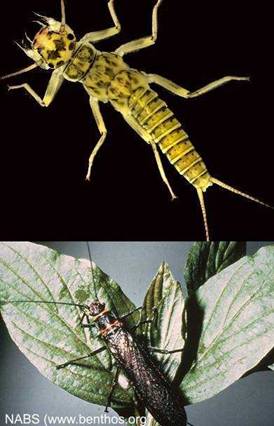Home → Water Quality → Monitoring & Reporting → Biomonitoring → Sampling & Analysis → Macroinvertebrate Types → Stoneflies
 Stonefly Larvae (Plecoptera)
Stonefly Larvae (Plecoptera)
Stoneflies are a type of insect that spends its juvenile life in the water and its adult life in the air and on land. Adult stoneflies lay their eggs in the water. When the larvae hatch from these eggs they look essentially like small adults with no wings. Each time they shed their skin they look a bit more like an adult stonefly. This type of life history is called incomplete metamorphosis.
Larval stoneflies, like all aquatic insects with incomplete metamorphosis, have three body segments and six segmented legs. They range in length from 5-70mm excluding antennae and tails, and can be distinguished from other aquatic insect larvae by their two long antennae, two long tails extending from the back of the abdomen, and the absence of gills on the sides of the abdomen (although gills are located on the thorax). Stoneflies spend 10-11 months as larvae, and only 1-4 weeks as adults.
Larval stoneflies are usually either detritivores that shred and eat large pieces of dead vegetation, or predators on other aquatic macroinvertebrates, although some do feed by scraping algae from the substrate. In contrast, all adult stoneflies that feed are vegetarians. Some types of stonefly don't feed as adults, although all drink. Their primary purpose as adults is to reproduce.
Larval stoneflies are found almost exclusively on coarse substrate such as boulders, cobble, pebbles, wood, and coarse detritus in fast-flowing water. They can inhabit rivers and streams of all sizes, but are found in the greatest numbers in small, cool, shaded streams with high dissolved oxygen. Stoneflies absorb this dissolved oxygen either through gills or, if gills are absent, through their skin. They are able to cope with low dissolved oxygen by doing push-ups that move water and oxygen over their bodies and gills.
Stoneflies play a beneficial role in the stream community. By feeding on large pieces of detritus they aid in the redistribution of its nutrients. Predacious stoneflies help to increase macroinvertebrate species diversity by feeding on true fly larvae. They are also one of the most pollution sensitive orders of aquatic insects. Along with caddisflies and mayflies, they are one of the three most commonly used indices of aquatic ecosystem health. Because their habitat requirements are so specific, their absence from a water body does not inherently mean that the water body is polluted. However, their presence is a reliable indicator of a high quality, minimally polluted stream.
Picture key
Top: Stonefly larva (Baumanella sp.)
Bottom: Adult stonefly (Pteronarcys princeps)
Source: The North American Benthological Society
Bibliography
Voshell, Jr., J. Reese; illustrated by Amy Bartlett Wright. 2002. A Guide to Common Freshwater Invertebrates of North America. Blacksburg (VA): The McDonald & Woodward Publishing Company. 442 p